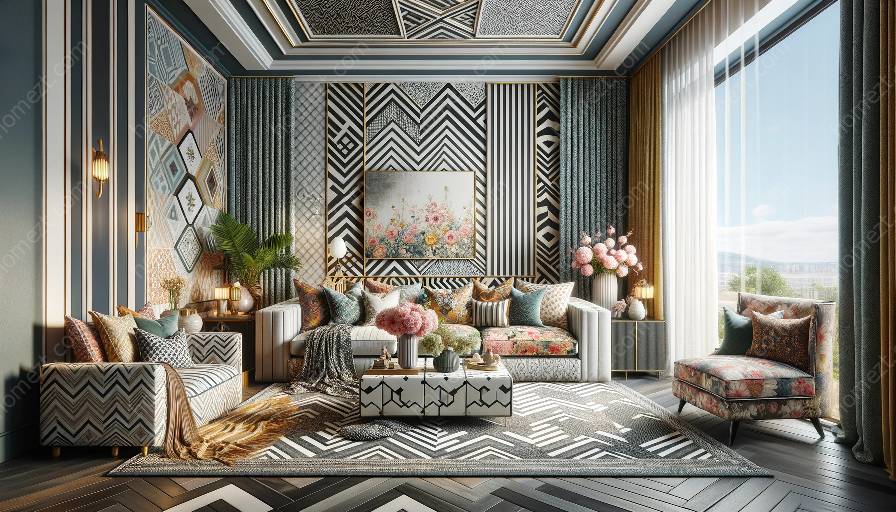Open-plan living and pattern mixing allow homeowners to create a dynamic, engaging, and stylish space that reflects their personality. This article explores the concepts of open-plan living and pattern mixing and provides practical tips for seamlessly integrating different patterns into your decorating.
Open-Plan Living: Embracing Space and Flexibility
What Is Open-Plan Living?
Open-plan living refers to the design concept that combines multiple functional areas, such as the kitchen, dining, and living rooms, into a single, open space. This design approach emphasizes a seamless flow between different zones, promoting a sense of connectivity and unity throughout the home.
Open-plan living is characterized by its flexible layout, which encourages interaction and socialization among family members and guests. By eliminating traditional barriers and walls, open-plan living spaces often feel more spacious, airy, and welcoming.
Advantages of Open-Plan Living
Open-plan living offers numerous benefits for homeowners, including:
- Enhanced natural light: The open layout allows light to travel freely throughout the space, creating a bright and inviting ambiance.
- Improved social interaction: Family members can engage in various activities while still being part of a shared conversation or experience.
- Flexible use of space: The absence of walls offers greater flexibility in arranging furniture and defining different functional zones.
- Visual continuity: A cohesive visual flow creates a harmonious and connected atmosphere within the home.
Creating Defined Areas
Despite the open layout, it's essential to create well-defined areas within the space to maintain a sense of order and purpose. This can be achieved through the strategic arrangement of furniture, distinct color palettes, and the use of decorative elements to signify different zones, such as dining, lounging, and cooking areas.
Pattern Mixing: Infusing Personality and Style
Understanding Pattern Mixing
Pattern mixing involves the art of combining different patterns, textures, and designs to create a visually captivating and dynamic interior. When executed thoughtfully, pattern mixing can add depth, character, and individuality to a space, making it more engaging and visually stimulating.
By incorporating various patterns, such as floral prints, geometric motifs, stripes, and abstract designs, homeowners can infuse their personal style and create a unique, layered look within their living spaces.
Tips for Successful Pattern Mixing
When embracing pattern mixing in decorating, consider the following tips:
- Scale and Proportion: Ensure that the scale and proportion of the patterns complement each other to maintain a balanced and cohesive aesthetic.
- Color Coordination: Select patterns with harmonious color palettes to unify the overall look while allowing individual patterns to stand out.
- Texture Variation: Introduce different textures alongside patterns to add depth and tactile appeal to the space.
- Layering Techniques: Experiment with layering patterns through textiles, upholstery, and accessories to achieve a multidimensional effect.
- Focal Points: Use patterns strategically to create focal points or accentuated areas within the space, drawing attention to specific elements or zones.
Integrating Pattern Mixing into Open-Plan Living
When incorporating pattern mixing into an open-plan living environment, it's essential to maintain a sense of cohesion and fluidity across the different functional areas. By strategically applying diverse patterns, homeowners can enhance the visual interest of their open-plan spaces while creating a harmonious and inviting atmosphere.
Coordinating Patterns Throughout the Space
Consider coordinating patterns across various elements, such as curtains, throw pillows, area rugs, and upholstery, to establish a cohesive visual narrative that ties different zones together. By repeating motifs or colors in different areas, homeowners can achieve a seamless transition between spaces, making the overall design feel cohesive and deliberate.
Creating Harmonious Contrasts
Introduce patterns with varying scales and intensities to create dynamic contrast and visual excitement within the open-plan living area. Contrast can infuse energy and personality into the space, making it more engaging and captivating for both residents and guests.
Embracing Individual Style
Pattern mixing offers homeowners a unique opportunity to express their individual style and creativity. By fearlessly blending different patterns and textures, homeowners can create a personalized and inviting environment that reflects their distinctive tastes and preferences.
Conclusion
Bringing It All Together
Open-plan living and pattern mixing are powerful design concepts that can elevate the aesthetics and functionality of a home. By embracing open-plan living, homeowners can create a versatile and inviting space that promotes connectivity and versatility. Simultaneously, by skillfully integrating pattern mixing into their decorating, they can infuse their living spaces with character, personality, and visual intrigue. When combined thoughtfully, open-plan living and pattern mixing enable homeowners to design a harmonious and captivating environment that reflects their unique style and enhances the overall appeal of their home.






































